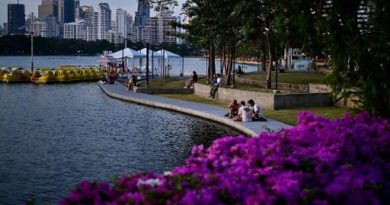OP-ED EDITORIAL & CARTOONS: The Philippine Star – But will she go to prison?
Over three decades after her family was forced into exile by a popular revolt, Imelda Marcos has been convicted of crimes committed during her husband’s dictatorial regime.
The Sandiganbayan found Marcos guilty of seven counts of graft in connection with private organizations she set up in Switzerland when she was a government official from 1968 to 1986. Each count carries from six to 11 years in prison.
Victims of the Marcos regime, however, know the country’s judicial system well enough not to celebrate prematurely. The case is expected to be appealed all the way to the Supreme Court, and the former first lady and her family have a formidable stable of lawyers known to be influential with the courts.
.ADS by Cloud 9:
.
– SPACE RESERVE FOR YOUR ADVERTISEMENT –
.
.
At 89 – and much older if ever the conviction is affirmed with finality – Marcos might also be spared by sympathetic magistrates of incarceration. The conviction for simple graft allows her to post bail. She is also expected to pursue her bid for reelection as congresswoman representing the second district of her husband’s bailiwick, Ilocos Norte, even if the sentence permanently disqualifies her from holding public office.
Still, the conviction sets a precedent for other cases pending against the heirs of dictator Ferdinand Marcos. The world, for example, has been confounded by the seizure of millions of dollars established to be ill-gotten and deposited in Swiss banks, and the Philippines’ failure to hold anyone accountable for the crime. Switzerland has turned over the deposits to the Philippine government, but no one has been brought to justice for the plunder.
.ADS by Cloud 9:
.
– SPACE RESERVE FOR YOUR ADVERTISEMENT –
.
.
The former first lady is still fighting efforts of the government to seize her collection of priceless paintings by the Masters. No president of this republic and his wife can ever earn on an honest wage in their entire lifetime the enormous sums needed to buy even one of those paintings. The Bangko Sentral ng Pilipinas also has in its safekeeping a king’s ransom in jewelry confiscated from the Marcoses as they fled the country.
And yet Ferdinand Marcos is buried at the heroes’ cemetery, and no Marcos has ever been convicted of corruption – until now. The question is whether Imelda Marcos will ever actually suffer the penalty for graft, or if her conviction will turn out to be nothing but a farce.
.ADS by Cloud 9:
.
– SPACE RESERVE FOR YOUR ADVERTISEMENT –
.
.
ASEANEWS EDITORIAL & CARTOONS:
7.1.DAILY TRIBUNE- Hot potato- DAILY TRIBUNE / – CONCEPT
– Manila’s lost glory
7.2. Manila Bulletin – Japan needs foreign workers in many fields
.ADS by Cloud 9:
.
– SPACE RESERVE FOR YOUR ADVERTISEMENT –
.
.

7.4 The Manila Times – DRUG MONEY


7.6 The Philippine Star – But will she go to prison?



The Straits Times says:
Welcome hubbub over hawker culture
.
The heated debate over the future of hawker centres here attests to the strength of the bond that Singaporeans have with hawker culture. In August, Prime Minister Lee Hsien Loong announced that Singapore would seek to have Singapore’s hawker culture listed as part of the intangible cultural heritage of humanity by the United Nations Educational, Scientific and Cultural Organisation (Unesco). While Singaporeans welcomed the bid, some questioned how sustainable hawker culture is. Hawker centres were built from 1971 to house street hawkers. Once they were successfully rehoused, the Government stopped building them, in 1986. Throughout the 1990s and 2000s, there were periodic appeals from MPs and residents to build new ones. In 2001, $420 million was set aside to upgrade existing hawker centres. In 2011, the Government relented and said it would build 10 new hawker centres over 10 years. An issue then arose as to who should run the new hawker centres and how to keep hawker culture sustainable – a debate that continues today. One solution implemented was to have social enterprises manage them. Most of the 117 hawker centres are now run by the National Environment Agency (NEA).
The economics of hawker centres is complex. Hawker stall rentals for the first generation of hawkers were subsidised. This helped keep cooked food prices low, as 81 per cent of residents eat at hawker centres, foodcourts or coffee shops at least twice a week. The challenge facing hawkers and those who run the centres is that of striking a balance between the provision of affordable food and managing business costs. Should future hawkers enjoy subsidised rental? How do you attract a new generation of hawker chefs to enter a trade with long hours, hot work conditions and low margins? Will Singaporeans used to $3 noodle and rice dishes pay more for hawker fare?
TO READ THE FULL ARTICLE: https://www.straitstimes.com/opinion/st-editorial/welcome-hubbub-over-hawker-culture
.
ADS by Cloud 9:
.
– SPACE RESERVE FOR YOUR ADVERTISEMENT –
.
.
 All photographs, news, editorials, opinions, information, data, others have been taken from the Internet ..aseanews.net | [email protected] |.For comments, Email to :D’Equalizer | [email protected] | Contributor
All photographs, news, editorials, opinions, information, data, others have been taken from the Internet ..aseanews.net | [email protected] |.For comments, Email to :D’Equalizer | [email protected] | Contributor












